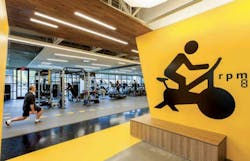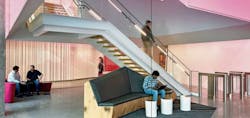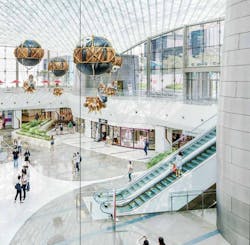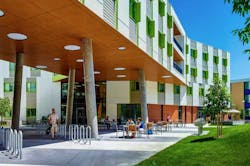8 of the most interesting trends from Gensler’s Design Forecast 2016
The year 2025 may seem like the distant future, but in reality, it is less than a decade away. And Gensler’s Design Forecast 2016 makes it seem even closer, as the architecture giant attempted to identify how people will live, play, and work in the cities of 2025.
We haven’t quite reached the point of flying cars, jetpacks, and moon colonies quite yet, but many of the design trends featured in the forecast are impressive in their forward thinking nonetheless.
The forecast lists over 30 trends whose beginnings are visible right now that are centered on the community sector, the workplace sector, and the lifestyle sector, and will shape the future cities of 2025. Additionally, Gensler lists six metatrends that will reach across all sectors and affect design trends.
Some of the big ideas on display are embracing a digital lifestyle, health and wellness, and the importance of consistency between the online and offline worlds.
In addition to the six overarching metatrends, we have selected what we believe to be eight of the most interesting, inspired, or just plain cool trends about to leave their fingerprints on each individual sector. Whether it is the community, work, or lifestyle sectors, there are big ideas for what the future holds in the year 2025.
The six mega trends identified by Gensler are:
Digital is here to stay, embrace it fully. Digital will be such an integral part of daily life that we’ll leverage it much more fully. We’ll accept how it interacts with us, consciously feeding its data streams to make our lives better. Our iHumanity will be a shared, global phenomenon, but different locales and generations will give it their own spin.
Everything around us will become “smarter.” We’ll live in a “made” environment, not just a “built” one. Buildings, settings, and products will integrate connectivity and “know” that we’re present. Most aspects of our everyday lives will reflect this, enabling us to make real-time, just-in-time connections to people, places, goods, and services.
In a world where time is money, speed is king. Hungry for experience and hooked on ultra-convenience, we won’t tolerate “dead time,” whether it’s long commutes, less-than-seamless transactions, or places devoid of interest. Design will reflect the reality that people will expect everything to justify their time commitment.
Urban centers must be connected via human networks. Urbanity creates an abundance of human networks to drive urban economies. To support new lifestyles, real estate will innovate its forms and means. Walkable, transit-served hubs that offer a rich, dense mix will absorb new growth. Many of them will be in former suburbs.
Neoindustrial cities will become innovation centers. Look for the emergence of neoindustrial cities that support thriving digital/artisanal maker cultures. Consumers will expect to co-create the goods and services they purchase. Makers—including freelancers and robots—will look to cities to provide tools and settings to speed innovation.
Health and safety will be a focal point, be it for one person or an entire city. In times of disruption, cities bear the brunt— disasters, epidemics, and security threats. They will take the lead in managing this, but citizens will play a role, armed with data and a mindset tuned to wellness, safety, and resilience. Smart cities will engage them and give their local efforts scale.
Here are the eight trends that the BD+C editors found most intriguing:
Community Sector Trends
1. Health and Wellness goes co-op: People will take a more active role in their own well-being and hospitals of tomorrow will reflect this
Websites such as WebMD have given people more information than ever before when it comes to trying to evaluate one’s own health. Forget the fact that sometimes it leads to bouts of rampant hypochondria, self-diagnostic and other personal care tools that are close at hand allow people the opportunity to stay as healthy as ever. Instead of just going to the doctor, people will begin to collaborate with their doctors and take an active part in their own healthcare.
Gensler says: Artificial intelligence will change health and wellness into a daily lifestyle pattern. People already turn to the web for immediate advice, while apps prompt them to stay healthy. In the near future, remote sensors will monitor them and communicate with their providers. As these options proliferate, inpatient hospitals and clinics will focus on serious health issues—using computers to aid diagnosis and design personalized therapies. Remote consultation is growing, and VR devices may extend the medical team’s reach. Labs are automating analysis and using apps to speed results to medical teams and patients.
The hospital of tomorrow might resemble the research lab of today, where boundaries between research, education, and clinical care disappear. As part of this network, the hospital will develop a new civic role that focuses on community health and well-being integrators, helping patient-consumers navigate the new structure.
2. Education will become more personal than ever
Learning is becoming more of a contact sport than ever before. Sitting in a traditional classroom and taking notes is giving way to more interactive, hands-on learning techniques. Many institutions are teaming up with outside partners to help better prepare students for job markets. Educational spaces are reflecting these new styles of learning and will continue to adapt over the next decade. Super-campuses will begin to pop up that combine K-12 and higher education to help create the best environments possible while spreading the costs.
Gensler says: Students’ cost-to-value issues could prod them to bypass traditional institutions for new options tied more closely to job markets and careers. Current certification is often proof of competency, even for degree holders. In some sectors, certification has actually supplanted degrees. It’s leading to new “schools” that tap online games and the Maker Movement as models. The responses from existing institutions include greater interactivity and self-direction, shorter and more career-targeted programs, and interdisciplinary STEM and STEAM programs. These shifts will generate a need for new, often hybrid, facilities.
Mixed use and alternative delivery approaches are very much in the picture. Taking a total-return view of new construction and retrofit, institutions look to data-driven design and operation to optimize their facilities and systems for long-term, holistic performance.
Work Sector
3. Technology Companies focus on engaging the individual worker
Technology companies have become some of the most innovative workplaces around as they seem to go from startup to multi-million dollar business overnight. These companies all seem to share the mentality that a strong, engaging workplace will help get the very best from their employees. The values of the company that are presented to the consumer will look to be reflected in the offices and headquarters of these businesses, as well.
Gensler says: Technology companies will seek to translate values of social responsibility and personal empowerment into their workplaces and policies. Look for resilience strategies—sustainability, transit, and housing; community engagement through programs and spaces; and leadership with wellness and other personal/social issues.
A fully interdependent, regenerative relationship between workplace, employees, and the community may shift “what success looks like” to have much broader measures. Tech companies will be much more interested in how people work and in creating work settings that support their diverse processes. The Internet of Things and smarter building systems will lead to a user-centric approach to the tech workplace. Highly adaptive settings and seamless support of mobility will allow for greater customization by teams and individuals.
This focus on the user experience will spur multifunctional and culturally unique work settings incorporating local references in their materials, fabrication, and products.
4. Government buildings go high-tech
Sure, maybe a government building isn’t going to be as unique, interesting, and inviting as, say, Google’s headquarters, but it doesn’t need to be drab and boring either. The government is supposed to reflective the views of its people, therefore, government buildings should be representative of the people’s culture and attitudes, as well. But that doesn’t mean functionality, safety, and efficiency can be sacrificed for aesthetics. Additionally, many services provided by the government will be moved completely online, eliminating such a large need for physical buildings.
Gensler says: Seeking greater efficiency, government may resemble healthcare by consolidating some functions into central hubs, while placing others closer to the communities they serve. Often this will happen in private-sector facilities, blurring the public-private boundary.
To enhance security, physical barriers will be augmented and potentially supplanted by active, technology-enabled surveillance that allows for a welcoming environment yet protects government buildings and workers. As their sophistication grows, these systems will detect, deter, and counter security threats—including drones—beyond the site boundaries of the building.
In addition, governments will shift to design-build and public-private partnerships to develop and operate their facilities without losing sight of goals for resilience, wellness, and productivity. End-user involvement in planning and robust change management will increase employees’ satisfaction with the facilities they occupy.
Lifestyle Sector
5. Retail centers will need to provide a reason to justify the trip
Thanks to technology and the increase in online shopping, retail centers need to offer more than just products to keep consumers filing through the doors. However, this doesn’t mean retail centers should be fearful of or have contempt for technology; it’s just the opposite, in fact. Retail centers will need to use and embrace technology without losing sight of the fact that they need to provide reasons for shoppers to come to the stores as opposed to shopping from their computers or smartphones at home.
Gensler says: As retail centers expand into urban markets, they’re increasingly catering to tech savvy customers. With every mall, store, and brand sitting comfortably in consumers’ pockets (on smartphones), successful retail centers will play by that mobile, 24/7 playbook. At the same time, they’ll use that playbook to identify shopping patterns and preferences.
In order to thrive, retail centers must proactively embrace technology to be accessible whenever and wherever COEX, Seoul Retail Centers Tech yes, but the destination is all the consumer wants them to be; they should be entrepreneurial and engaged. Payment systems capable of integrating other layers of information will create richer, more personalized interactions between retail centers and their customers. Cashless payments and augmented reality can help tie them together with a smaller footprint.
Retail centers will still need to deliver experiences that justify the customer’s journey. As with mixed use, their destination value is a differentiator. Events and other draws will leverage tech’s reach to find audiences and cue up followers.
6. For Sports Arenas, Fans come first
Sports stadiums will continue a trend of providing people with an experience that goes beyond just that of watching a game live and in person. It used to be enough to just provide seats with a view of the field and offer a few simple options for vittles. Now, sporting events are beginning to focus as much on the ‘events’ part as the ‘sporting’ aspect.
Gensler says: Sports venues are becoming ever more interconnected. Environmental immersion takes this to the next level, creating opportunities for interactive engagement. Venue-specific tech offerings, from augmented reality photo zones to push-notified promotional opportunities, transform spectators into active participants.
Stadiums are the next frontier for wearables, generating infinite opportunities for product customization and collectibility for fans, and revenue advantages through promotions and analytics for teams. A single wearable device can act as your ticket, room key, fast pass, map, crowd flow monitor, and credit card.
The desire for authenticity and tailored experiences will propel the next generation of venues, which will avoid the generic and celebrate the local.
7. As the population grows, so will vertical living
When there is no more room to grow outward, the only place to go is up. Especially in large cities with dense populations, this vertical living is not only set to become more popular, but will also become more comfortable and high-tech. And thanks to new technology, the time it takes a building to be completed will be reduced greatly.
Gensler says: The increasing use of split, offset, and perimeter cores in new towers reflects this. These core arrangements offer greater flexibility in adapting buildings to future requirements, and make it easier to introduce interior stairs and atria that connect tenant floors and provide daylight and natural ventilation.
Façades are no longer for weather protection only; they are an integral part of a tower’s strategy for reducing energy use and increasing human comfort and amenity. Double skins have given way to truly usable interstitial spaces. Nanotechnology will make skins more environmentally responsive. New materials will also reduce the weight of façades while improving their performance.
Vertical living offers opportunities for densely populated cities to accommodate growth, and Asia will continue to lead the charge. But the market for tall buildings is expanding as Chinese and other offshore investors and developers are moving into overseas markets, including Europe and the United States. Residential towers are a fast-growing category in these markets.
8. The Suburbs won’t be what they used to
The suburbs are set to become more densely populated and more urban with every year. This brings with it things like communal housing that will be beneficial to post-college adults, single parents, and the elderly. New developments in the residential sector require more than just a place to live; schools, work and gathering places, and easy access to services are all necessities. As residential lifestyles change, the landscape needs to change with it.
Gensler says: Within the next 10 years, the continued trends of urban and suburban densification and global urbanization will have changed the residential landscape in larger markets and will be under way in smaller markets. Fueled by the sharing economy and the cost of personal home ownership, communal housing will become acceptable to residential segments like post-college adults, single parents, and the elderly.
Changes in work style and lifestyle will increase the need for part-time housing as people with mobile lifestyles seek places that pair the conveniences of a hotel with the comfort and familiarity of home. In response to these changes, mixed-use developments are increasingly introducing a housing component.
The suburb isn’t dead, but it craves the advantages of city living. That’s leading to an emerging residential market, the “uburb,” midway between the city and the suburb. Some large employers are collocating with them to tap their housing, amenities, and transit accessibility.
See the entire 2016 forecast here.








